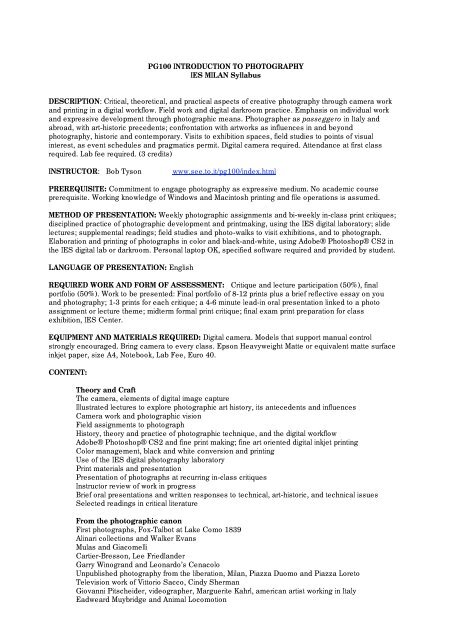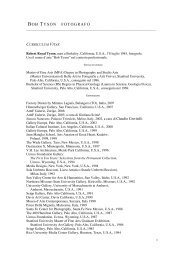PG100 INTRODUCTION TO PHOTOGRAPHY IES MILAN Syllabus ...
PG100 INTRODUCTION TO PHOTOGRAPHY IES MILAN Syllabus ...
PG100 INTRODUCTION TO PHOTOGRAPHY IES MILAN Syllabus ...
Create successful ePaper yourself
Turn your PDF publications into a flip-book with our unique Google optimized e-Paper software.
<strong>PG100</strong> <strong>INTRODUCTION</strong> <strong>TO</strong> PHO<strong>TO</strong>GRAPHY<br />
<strong>IES</strong> <strong>MILAN</strong> <strong>Syllabus</strong><br />
DESCRIPTION: Critical, theoretical, and practical aspects of creative photography through camera work<br />
and printing in a digital workflow. Field work and digital darkroom practice. Emphasis on individual work<br />
and expressive development through photographic means. Photographer as passeggero in Italy and<br />
abroad, with art-historic precedents; confrontation with artworks as influences in and beyond<br />
photography, historic and contemporary. Visits to exhibition spaces, field studies to points of visual<br />
interest, as event schedules and pragmatics permit. Digital camera required. Attendance at first class<br />
required. Lab fee required. (3 credits)<br />
INSTRUC<strong>TO</strong>R: Bob Tyson www.see.to.it/pg100/index.html<br />
PREREQUISITE: Commitment to engage photography as expressive medium. No academic course<br />
prerequisite. Working knowledge of Windows and Macintosh printing and file operations is assumed.<br />
METHOD OF PRESENTATION: Weekly photographic assignments and bi-weekly in-class print critiques;<br />
disciplined practice of photographic development and printmaking, using the <strong>IES</strong> digital laboratory; slide<br />
lectures; supplemental readings; field studies and photo-walks to visit exhibitions, and to photograph.<br />
Elaboration and printing of photographs in color and black-and-white, using Adobe® Photoshop® CS2 in<br />
the <strong>IES</strong> digital lab or darkroom. Personal laptop OK, specified software required and provided by student.<br />
LANGUAGE OF PRESENTATION: English<br />
REQUIRED WORK AND FORM OF ASSESSMENT: Critique and lecture participation (50%), final<br />
portfolio (50%). Work to be presented: Final portfolio of 8-12 prints plus a brief reflective essay on you<br />
and photography; 1-3 prints for each critique; a 4-6 minute lead-in oral presentation linked to a photo<br />
assignment or lecture theme; midterm formal print critique; final exam print preparation for class<br />
exhibition, <strong>IES</strong> Center.<br />
EQUIPMENT AND MATERIALS REQUIRED: Digital camera. Models that support manual control<br />
strongly encouraged. Bring camera to every class. Epson Heavyweight Matte or equivalent matte surface<br />
inkjet paper, size A4, Notebook, Lab Fee, Euro 40.<br />
CONTENT:<br />
Theory and Craft<br />
The camera, elements of digital image capture<br />
Illustrated lectures to explore photographic art history, its antecedents and influences<br />
Camera work and photographic vision<br />
Field assignments to photograph<br />
History, theory and practice of photographic technique, and the digital workflow<br />
Adobe® Photoshop® CS2 and fine print making; fine art oriented digital inkjet printing<br />
Color management, black and white conversion and printing<br />
Use of the <strong>IES</strong> digital photography laboratory<br />
Print materials and presentation<br />
Presentation of photographs at recurring in-class critiques<br />
Instructor review of work in progress<br />
Brief oral presentations and written responses to technical, art-historic, and technical issues<br />
Selected readings in critical literature<br />
From the photographic canon<br />
First photographs, Fox-Talbot at Lake Como 1839<br />
Alinari collections and Walker Evans<br />
Mulas and Giacomelli<br />
Cartier-Bresson, Lee Friedlander<br />
Garry Winogrand and Leonardo’s Cenacolo<br />
Unpublished photography from the liberation, Milan, Piazza Duomo and Piazza Loreto<br />
Television work of Vittorio Sacco, Cindy Sherman<br />
Giovanni Pitscheider, videographer, Marguerite Kahrl, american artist working in Italy<br />
Eadweard Muybridge and Animal Locomotion
Examples of photo assignments<br />
Public space and the monumental<br />
Landscape, geometry, structures<br />
Personification<br />
The voyager and the journey<br />
Interiors, the view from the window, visitations<br />
Photo walks or field studies<br />
Basilica di Sant’Ambrogio<br />
Cimitero Monumentale<br />
MediaWorld, Quarto Oggiaro (La Periferia)<br />
Stazione Centrale<br />
Piazza Duomo, roof of the cathedral<br />
Sacra di San Michele, Val di Susa<br />
Saturday markets, Isola, Scalo Porta Romana<br />
Exhibition spaces<br />
Museo Nazionale Alinari della Fotografia, Florence<br />
PAC Milano<br />
Forma Milano<br />
Galleria Carla Sozzani<br />
Galerie ArteF, Zurich<br />
Museo Ken Damy, Brescia<br />
REQUIRED READING<br />
Excerpts from (texts will be provided in class):<br />
Gillo Dorfles, Kitsch: The World of Bad Taste<br />
Roger Scruton, Kitsch and the Modern Predicament, City Journal, Winter 1999<br />
Artisti Americani tra le Due Guerre, Pola, Scimé,Tedeschi, editors, Vita e Pensiero, Milan, 2004<br />
Susan Sontag, On Photography, Picador USA, 2001<br />
Rebecca Solnit, River of Shadows, Penguin, New York, 2003<br />
RECOMMENDED READING<br />
For tutorials and technical help with Photoshop, color management, and inkjet printing, online searches<br />
globally and on the Adobe support and user forum web pages provide extensive information. More<br />
specific recommendations will be available during the course.<br />
On Milan and Italy:<br />
Alessandro Manzoni, I Promessi Sposi (The Betrothed, available in an excellent<br />
English translation by Bruce Penman, Penguin Classics)<br />
Paul Hofmann, That Fine Italian Hand<br />
Tobias Jones, The Dark Heart of Italy<br />
BIO: Bob Tyson is an American photographer who has lived in Italy since 2002. After photographing<br />
Milan sculptor Mauro Staccioli’s work in California in 1988 he began to frequent Staccioli’s projects in<br />
Italy, and began to see that from Italian art and life a certain significance and timelessness began to enter<br />
his photographs. Of these sources he says, ‘The appearances of things here inform my photography with<br />
an essence I hope will be present to those who look at my pictures.’<br />
Bob Tyson has held artist’s residencies at The Djerassi Resident Artist Program, The Helene Wurlitzer<br />
Foundation of New Mexico, and The Ucross Foundation, and teaches photography at Università Cattolica<br />
del Sacro Cuore, Brescia. He majored in geology at Stanford University, then turned to photography<br />
during a career as an engineering geologist and received the Master of Fine Arts degree from Stanford in<br />
1986. He photographs artists’ works extensively in Italy and exhibits his work at Galerie ArteF für<br />
Kunstfotografie, Zurich.<br />
22 jan 2008



